Earlier this spring Turner Classic Movies launched their first ever “TCM Classic Film Festival” in the heart of old Hollywood, dubbed by indefatigable and omnipresent master of ceremonies Robert Osborne as “four days of … classic Cinemania.” Indeed at times it was a delightfully surreal circus, but one grounded in the appreciation of the best of Hollywood’s past – a mutual admiration society where filmmakers from Hollywood’s golden era (and beyond) could see their pristine works presented in the ideal environment to the most appreciative of audiences. In what will hopefully become a longstanding tradition (a 2011 follow-up festival has already been announced), the festival blended old Hollywood glamour with insightful discussions by the craftsmen and women who created the many great classics on display. With so many of filmdom’s glitterati in attendance, it was nice to be reminded that being a cinephile and a starstruck movie fan are not necessarily mutually exclusive.
The four-day festival was held in the nexus of old Hollywood, encompassing the Grauman’s Chinese Theatre, the Hollywood Roosevelt Hotel, and Grauman’s Egyptian – all within a short walk of each other on increasingly surreal Hollywood Blvd. Who says you need a car in Los Angeles? In fact, one might even subway it to the fest directly from the airport, with Metro’s pink line terminus depositing you directly out front of the Kodak theater, amongst the costumed Marilyn imitators, the busloads of gawking tourists, and maybe even Tony Curtis looking dapper in his wheelchair and Stetson hat!
The festival’s programming was an embarrassment of riches, yet also a source of frustration knowing that one would have to choose between many once-in-a-lifetime presentations. Does one opt for the opening night premiere of A Star is Born at Grauman’s Chinese, or the never-to-be-repeated Roosevelt Hotel poolside screening of Neptune’s Daughter, with MGM aquatic legend Esther Williams in attendance? Should one see Jean-Paul Belmondo introducing Breathless on its 50th anniversary, or instead hear Jon Voight speaking of his great triumph that bookended the decade, Midnight Cowboy? Buck Henry discusses his work on The Graduate while just down the block Stanley Donen introduces the greatest musical of all time, his Singin’ in the Rain. (Not to even mention Danny Huston discussing his overlooked neo-classic The Proposition at the very same time.) Tony Curtis introduces cinema’s great comedy Some Like It Hot, while simultaneously over at Grauman’s Chinese the Alloy Orchestra accompanies the restored presentation of Fritz Lang’s 1927 masterpiece, Metropolis. How to choose between so many fantastic options? Luckily, Jerry Lewis made one scheduling conflict easier with a last-minute cancellation at his The King of Comedy screening. This opened up the opportunity to attend a rare and delightful appearance by 100-year-old Oscar legend Luise Rainer, who had managed to fly in from Europe to discuss her charmed life, and introduce her Oscar-winning performance in The Good Earth.
While it might have seemed a no-brainer for that 1937 epic on life in old China to actually be screened at Grauman’s Chinese Theatre, it instead was curiously presented down the block at the Egyptian, soon after the more geographically appropriate Cleopatra was shown. While awaiting Rainer’s appearance in the Egyptian courtyard, it was fun to overhear one historically challenged viewer, after sitting through Elizabeth Taylor’s dubious epic, turn to her companion and say, “She died of a snakebite?!? That’s really hardcore.” Spotted out front moments after this, one of Hollywood Blvd.’s shirtless crazies leaps down atop Cate Blanchett’s sidewalk star and starts doing a series of push-ups, followed by a tender kiss, and finishes up by lovingly polishing Cate’s golden star with his stockinged foot. What a perfect, inappropriately fun Hollywood build-up for what was to become, for me, the eventual highlight of the festival.
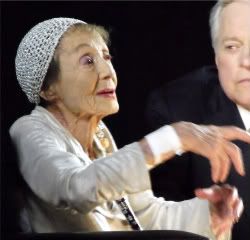 Mere minutes later, inside the cavernous Egyptian Theatre, the fragile and beautiful Luise Rainer was escorted to the stage to converse with enraptured host Robert Osborne. Because Miss Rainer’s hearing aid had broken in an unfortunate hotel room fall earlier that morning, Osborne was forced to improvise, and asked his questions by writing them down on a large pad of paper. The discussion was being filmed for a future TCM broadcast, and Luise – ever the actress – animatedly played to the camera. This was her moment (her final Hollywood close-up?), and she charmingly played it to the hilt, her tiny hands gesturing with delicate expression, eyes lit up with wonder.
Mere minutes later, inside the cavernous Egyptian Theatre, the fragile and beautiful Luise Rainer was escorted to the stage to converse with enraptured host Robert Osborne. Because Miss Rainer’s hearing aid had broken in an unfortunate hotel room fall earlier that morning, Osborne was forced to improvise, and asked his questions by writing them down on a large pad of paper. The discussion was being filmed for a future TCM broadcast, and Luise – ever the actress – animatedly played to the camera. This was her moment (her final Hollywood close-up?), and she charmingly played it to the hilt, her tiny hands gesturing with delicate expression, eyes lit up with wonder.
Rainer made Oscar history back in 1936 and 1937 by becoming the first performer to win back-to-back Academy Awards. Quite the feat, considering her roles were almost supporting in length, and yet she won both coveted Best Actress prizes against some of Hollywood’s greatest (and ultimately Oscarless) actresses, in arguably their best performances. Irene Dunne in The Awful Truth, Barbara Stanwyck in Stella Dallas, Carole Lombard in My Man Godfrey, and even the great Greta Garbo in Camille … all trumped by a poor, lucky little Viennese Teardrop in the eyes of the Academy.
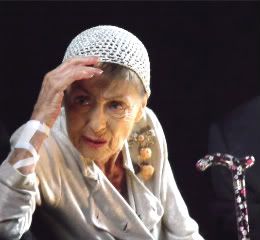 Sadly Rainer’s MGM champion, boy-wonder Irving Thalberg, had died during production of The Good Earth, and when Louis B. Mayer took over production control on the lot, he began to make life hell for Luise. Realizing that she no longer wished to be just a cog in the all-encompassing motion picture machine, she defiantly threw in the towel and returned to Europe, where by her own account she’s lived a wonderful, enriched, and beautiful life. Unfortunately, even Fellini couldn’t coax her from her self-imposed retirement for a role in La Dolce Vita, perhaps because her life was sweet enough already.
Sadly Rainer’s MGM champion, boy-wonder Irving Thalberg, had died during production of The Good Earth, and when Louis B. Mayer took over production control on the lot, he began to make life hell for Luise. Realizing that she no longer wished to be just a cog in the all-encompassing motion picture machine, she defiantly threw in the towel and returned to Europe, where by her own account she’s lived a wonderful, enriched, and beautiful life. Unfortunately, even Fellini couldn’t coax her from her self-imposed retirement for a role in La Dolce Vita, perhaps because her life was sweet enough already.
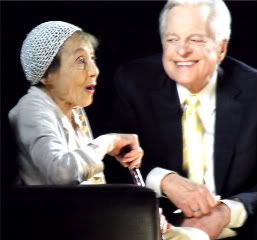 It was a privilege and a joy to hear this enchanting woman speak personally of cinema’s early days, of her meteoric rise to the top, and then ultimate escape from Hollywood. It would’ve been nice to hear her reminisce for hours (rather than sit through the not-so Good Earth again), as her anecdotes of old Hollywood were sharply insightful and beautifully, emotionally expressed. She spoke of the many great artists that she’d crossed paths with, from her not particularly caring for Good Earth co-star Paul Muni, to absolutely adoring Irving Thalberg, “a wonderful, big character,” and loving husband Clifford Odets, “a beautiful, heavenly guy.” She swooned over Garbo: “She had a face, my god. She was like Nefertiti,” followed by the delightfully random addendum, “She had big feet.”
It was a privilege and a joy to hear this enchanting woman speak personally of cinema’s early days, of her meteoric rise to the top, and then ultimate escape from Hollywood. It would’ve been nice to hear her reminisce for hours (rather than sit through the not-so Good Earth again), as her anecdotes of old Hollywood were sharply insightful and beautifully, emotionally expressed. She spoke of the many great artists that she’d crossed paths with, from her not particularly caring for Good Earth co-star Paul Muni, to absolutely adoring Irving Thalberg, “a wonderful, big character,” and loving husband Clifford Odets, “a beautiful, heavenly guy.” She swooned over Garbo: “She had a face, my god. She was like Nefertiti,” followed by the delightfully random addendum, “She had big feet.”
 All told, Miss Rainer appears to have lived a full and charmed century of life, and her return to be feted by the town where she once sparkled at its pinnacle was a poignant and moving moment in time. Justified or not, one must remember that it really wasn’t Luise’s fault that she won those two accursed Oscars (and the subsequent unrealistic expectations which followed), yet the decision to turn her back on Hollywood was all hers, and perfectly apropos. Rainer, a curious seeker of intelligence and beauty throughout her many years, seems to have figured out what is important in life, and summed up her craft by stating, “I don’t believe in acting, I believe in being.” Her appearance here was enchanted, and by the end of the discussion she had the audience (and Osborne) in the palm of her hand. It’s moments such as this that will make the TCM Festival a rare and special cinematic celebration of Hollywood’s rich history, hopefully for many a year to come.
All told, Miss Rainer appears to have lived a full and charmed century of life, and her return to be feted by the town where she once sparkled at its pinnacle was a poignant and moving moment in time. Justified or not, one must remember that it really wasn’t Luise’s fault that she won those two accursed Oscars (and the subsequent unrealistic expectations which followed), yet the decision to turn her back on Hollywood was all hers, and perfectly apropos. Rainer, a curious seeker of intelligence and beauty throughout her many years, seems to have figured out what is important in life, and summed up her craft by stating, “I don’t believe in acting, I believe in being.” Her appearance here was enchanted, and by the end of the discussion she had the audience (and Osborne) in the palm of her hand. It’s moments such as this that will make the TCM Festival a rare and special cinematic celebration of Hollywood’s rich history, hopefully for many a year to come.
 In addition to Miss Rainer’s personal brush with Oscar, many more Academy Award-winning films played an integral part in the TCM Festival’s programming. So it was appropriate that the Roosevelt Hotel’s “Blossom Room” was transformed into the festival’s hub, nicknamed “Club TCM.” This small, intimate room was the site of the very first Academy Awards banquet held back in 1929, and exuded a hushed, almost churchlike stillness. This Deco throwback to the Academy’s humble beginnings was the ideal setting for fans and filmmakers to meet and talk film history. Here one could watch and discuss Joan Crawford’s home movies with her grandson, listen to special-effects maestro Douglas Trumbull speak of working with Kubrick on 2001, or even have the ever-appreciative Tony Curtis sign his autobiography while sitting amongst his colorful artwork.
In addition to Miss Rainer’s personal brush with Oscar, many more Academy Award-winning films played an integral part in the TCM Festival’s programming. So it was appropriate that the Roosevelt Hotel’s “Blossom Room” was transformed into the festival’s hub, nicknamed “Club TCM.” This small, intimate room was the site of the very first Academy Awards banquet held back in 1929, and exuded a hushed, almost churchlike stillness. This Deco throwback to the Academy’s humble beginnings was the ideal setting for fans and filmmakers to meet and talk film history. Here one could watch and discuss Joan Crawford’s home movies with her grandson, listen to special-effects maestro Douglas Trumbull speak of working with Kubrick on 2001, or even have the ever-appreciative Tony Curtis sign his autobiography while sitting amongst his colorful artwork.
From Club TCM it is only a short stroll down a garden path to the calm oasis of the Roosevelt Hotel pool, where on the festival’s first night, a unique Hollywood experience unfolded. There fest-goers gathered on poolside chaises under the twinkling light-draped palms as the warm Hollywood evening turned to dusk, all to honor the rare appearance of MGM’s aquatic legend, Esther Williams.
 One of MGM’s top box-office stars of the ’40s and ’50s, Miss Williams sat poolside to watch a troupe of synchronized swimmers splash at her feet, a fitting tribute to the person probably most responsible for popularizing the (now Olympic) sport. After the Waterlilies concluded their aquatic show, Miss Williams and Neptune’s Daughter co-star Betty Garret spoke briefly before the Oscar-winning film unspooled on a large outdoor screen.
One of MGM’s top box-office stars of the ’40s and ’50s, Miss Williams sat poolside to watch a troupe of synchronized swimmers splash at her feet, a fitting tribute to the person probably most responsible for popularizing the (now Olympic) sport. After the Waterlilies concluded their aquatic show, Miss Williams and Neptune’s Daughter co-star Betty Garret spoke briefly before the Oscar-winning film unspooled on a large outdoor screen.
Events such as this gave movie fans of classic Hollywood ample opportunities to mingle and rub elbows with some of filmdom’s acting royalty. What Hitchcock devotee wouldn’t be thrilled to compliment Tippi Hedron on her work in The Birds, or be awestruck at the timeless beauty of gracious Jacqueline Bisset? To balance the appearance of Luise Rainer (Oscar’s oldest living actress), 93-year-old Oscared actor Ernest Borgnine also made an appearance, looking hale and fit, to introduce his obscure 1956 classic Jubal. While most visitors to the Grauman’s Chinese courtyard likely have no idea who Jane Withers is, there she was again in the flesh, over seventy years after she put her foot and handprints in the wet cement.
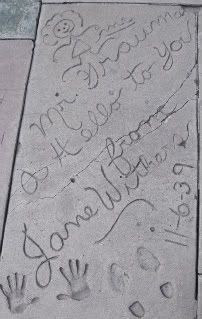

Down the block, Mel Brooks and Carl Reiner yucked it up outside the Egyptian as Mel was presented with his own star on Hollywood Blvd. While providing many great laughs during the presentation, Mel also was surprisingly sentimental, as he spoke lovingly of his departed wife Anne Bancroft and their son and grandson (whom Mel dines with nightly).
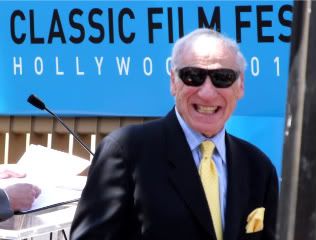 But perhaps one of the most thrilling moments for me was being able to meet siblings Danny and Anjelica Huston (Hollywood royalty indeed) and compliment them on their respective indelible performances in The Proposition and The Grifters. Just prior to this encounter, a pristine print of their father’s great cynical classic The Treasure of the Sierra Madre (which brought deserved Oscars to both John and Walter Huston) had screened inside the Chinese Theatre. Danny and Anjelica reminisced about the film beforehand, how they’d watched it countless times projected onto a sheet hanging from their Irish castle’s wall while growing up. What a thrill it must have been to see perhaps their father and grandfather’s greatest work, presented in this very different environment, before such an appreciative and receptive audience. Believe me, the thrill was mutual.
But perhaps one of the most thrilling moments for me was being able to meet siblings Danny and Anjelica Huston (Hollywood royalty indeed) and compliment them on their respective indelible performances in The Proposition and The Grifters. Just prior to this encounter, a pristine print of their father’s great cynical classic The Treasure of the Sierra Madre (which brought deserved Oscars to both John and Walter Huston) had screened inside the Chinese Theatre. Danny and Anjelica reminisced about the film beforehand, how they’d watched it countless times projected onto a sheet hanging from their Irish castle’s wall while growing up. What a thrill it must have been to see perhaps their father and grandfather’s greatest work, presented in this very different environment, before such an appreciative and receptive audience. Believe me, the thrill was mutual.
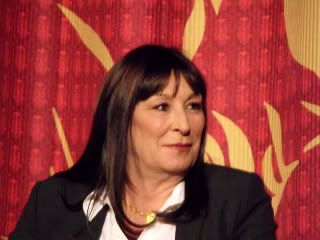 Frustration with overlapping screenings aside, the Friday of the festival looked to be a Francophile film lover’s dream come true. Through some magical quirk in scheduling, the nearby Director’s Guild of America was presenting their 14th COL-COA festival, a week of French film premieres in Hollywood. An afternoon screening of Jean-Luc Godard’s restored Pierrot le Fou was scheduled, along with a post-film discussion featuring Godard’s muse (and perhaps most beautiful woman ever to grace the silver screen), Anna Karina. While this presentation was a completely separate affair, through some quirk of the cinematic gods, the TCM fest had scheduled for later that evening a 50th anniversary screening of Godard’s seminal Breathless, and this with Pierrot co-star Jean-Paul Belmondo in attendance. This one-two punch seemed almost too good to be true, and alas, sadly turned out to be. Miss Karina had tried valiantly up until the very last minute to get on a flight out of Europe, but due to the spewing of an errant Icelandic volcano, her flights had all been cancelled and she was not able to attend. Still, the state-of-the-art DGA screening was a huge success, the restored color of Godard’s masterpiece literally popping off the screen. A fascinating in-depth discussion followed, with maverick filmmaker Monte Hellman revealing the impact this film had on him throughout his career. One cannot help cursing Odin (or whichever volcanic god was responsible), for preventing this dream dual Belmondo-Karina appearance, for that would’ve been something truly magnifique.
Frustration with overlapping screenings aside, the Friday of the festival looked to be a Francophile film lover’s dream come true. Through some magical quirk in scheduling, the nearby Director’s Guild of America was presenting their 14th COL-COA festival, a week of French film premieres in Hollywood. An afternoon screening of Jean-Luc Godard’s restored Pierrot le Fou was scheduled, along with a post-film discussion featuring Godard’s muse (and perhaps most beautiful woman ever to grace the silver screen), Anna Karina. While this presentation was a completely separate affair, through some quirk of the cinematic gods, the TCM fest had scheduled for later that evening a 50th anniversary screening of Godard’s seminal Breathless, and this with Pierrot co-star Jean-Paul Belmondo in attendance. This one-two punch seemed almost too good to be true, and alas, sadly turned out to be. Miss Karina had tried valiantly up until the very last minute to get on a flight out of Europe, but due to the spewing of an errant Icelandic volcano, her flights had all been cancelled and she was not able to attend. Still, the state-of-the-art DGA screening was a huge success, the restored color of Godard’s masterpiece literally popping off the screen. A fascinating in-depth discussion followed, with maverick filmmaker Monte Hellman revealing the impact this film had on him throughout his career. One cannot help cursing Odin (or whichever volcanic god was responsible), for preventing this dream dual Belmondo-Karina appearance, for that would’ve been something truly magnifique.
Still, one must be grateful for all the many talented filmmakers who were able to converge in the heart of Hollywood for this newest film celebration. One can only hope it is the start of a great festival tradition, one that brings together appreciative filmgoers with the filmmakers who’ve made such lasting cinematic contributions. The thrill of seeing these classics presented in all their big-screen glory, alongside the very filmmakers who helped create them, was an indelible cinematic experience. Hats off to TCM, the festival programmers, Robert Osborne, and all the participants for making this a thrilling and unique celebration of film. Bravo!
